Complete Guide to Fort McHenry National Monument and Historic Shrine located in Baltimore, Maryland! This guide includes history, things to do, where to stay, nearby camping, and so much more!
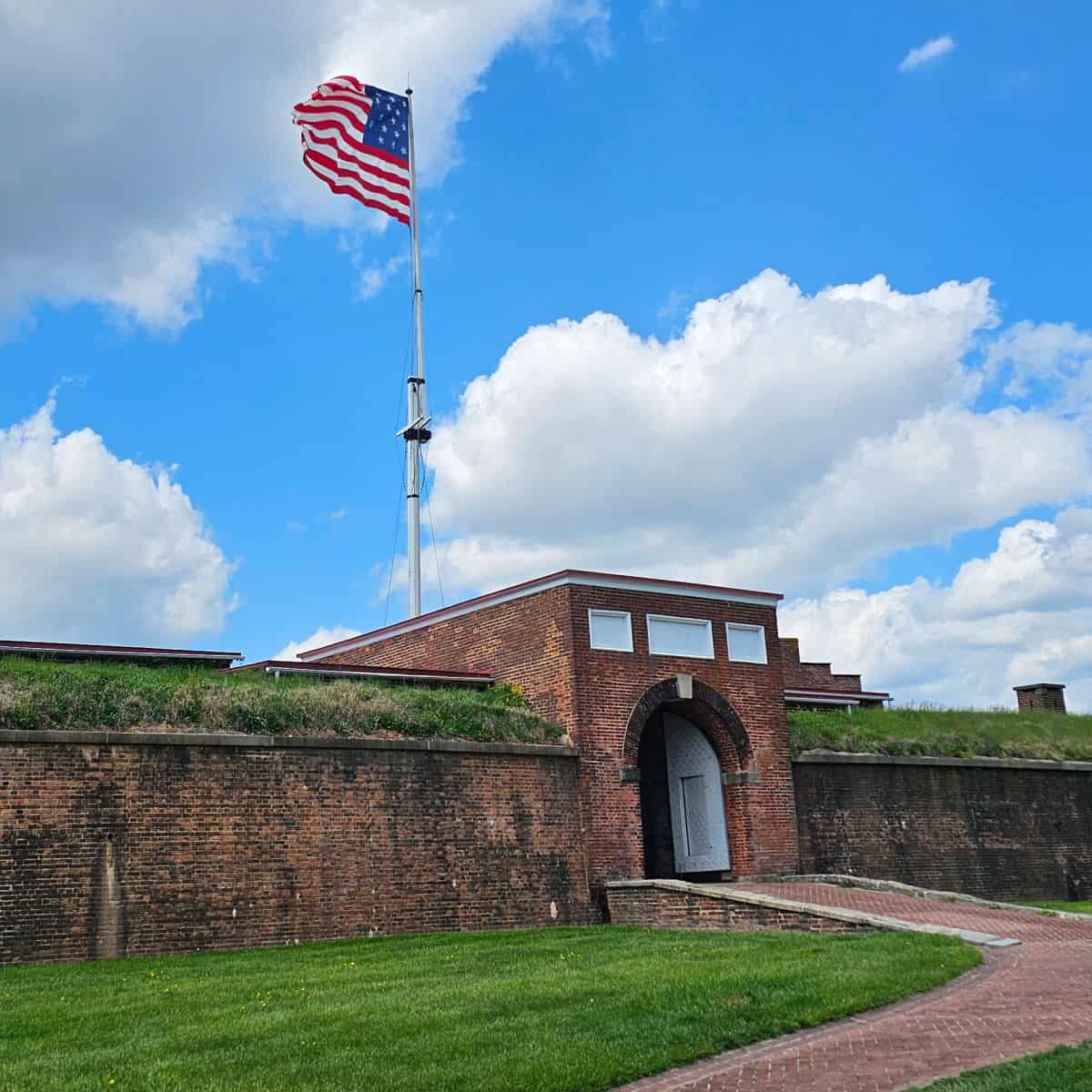
Fort McHenry National Monument and Historic Shrine
Visiting Fort McHenry National Monument & Historic Shrine is a must for its historical significance in shaping the United States and being the birthplace of the national anthem.
The engaging exhibits and programs, family-friendly activities, and picturesque waterfront setting make it a memorable and accessible destination for all ages.
By visiting, you'll immerse yourself in American heritage and walk in the footsteps of those who helped shape the nation's history.
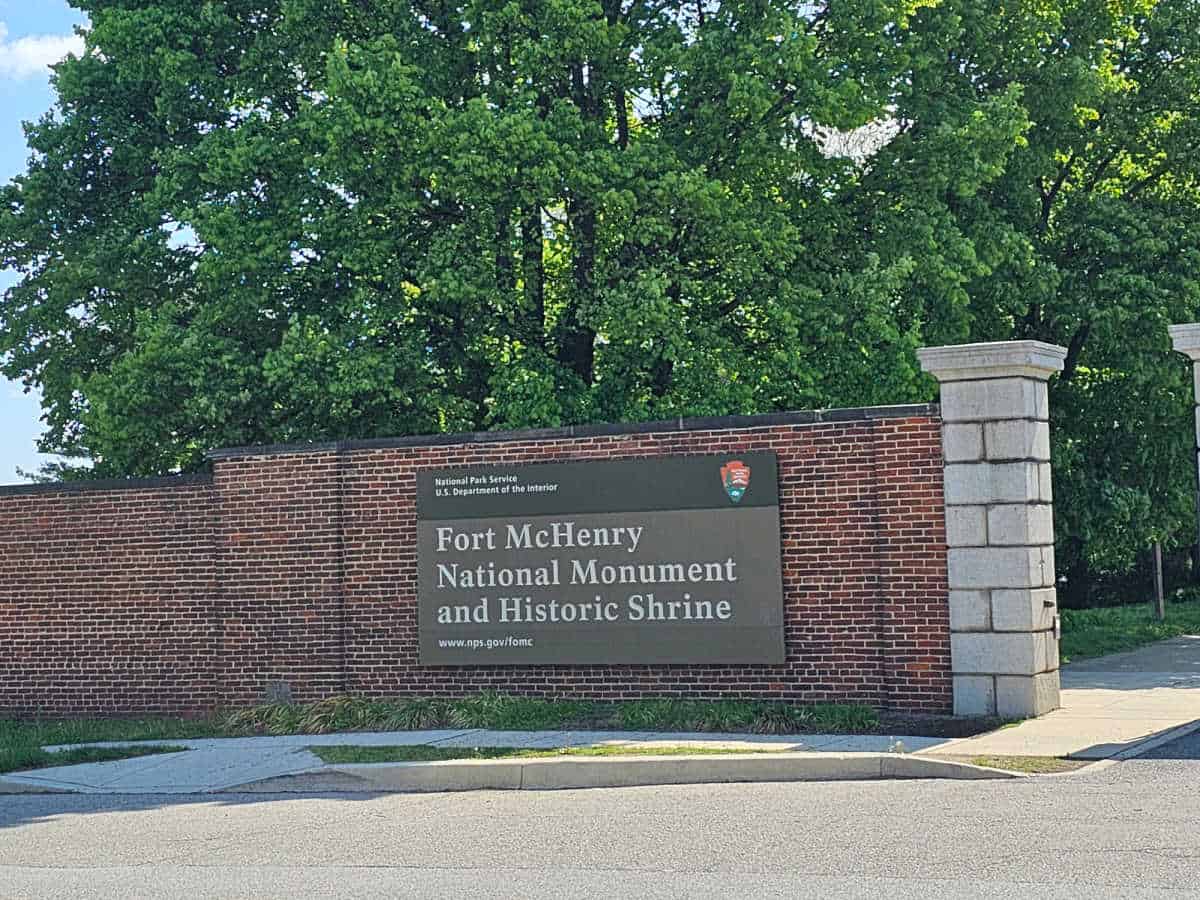
Is Fort McHenry National Monument and Historic Shrine worth visiting?
We absolutely loved our time exploring Fort McHenry. The park is gorgeous and a must visit.
Make sure to watch the park film and stay until the end. The entire production was one of the best we have seen in any of the 300+ national park sites we have visited.
People were clapping and cheering at the end it was that good.
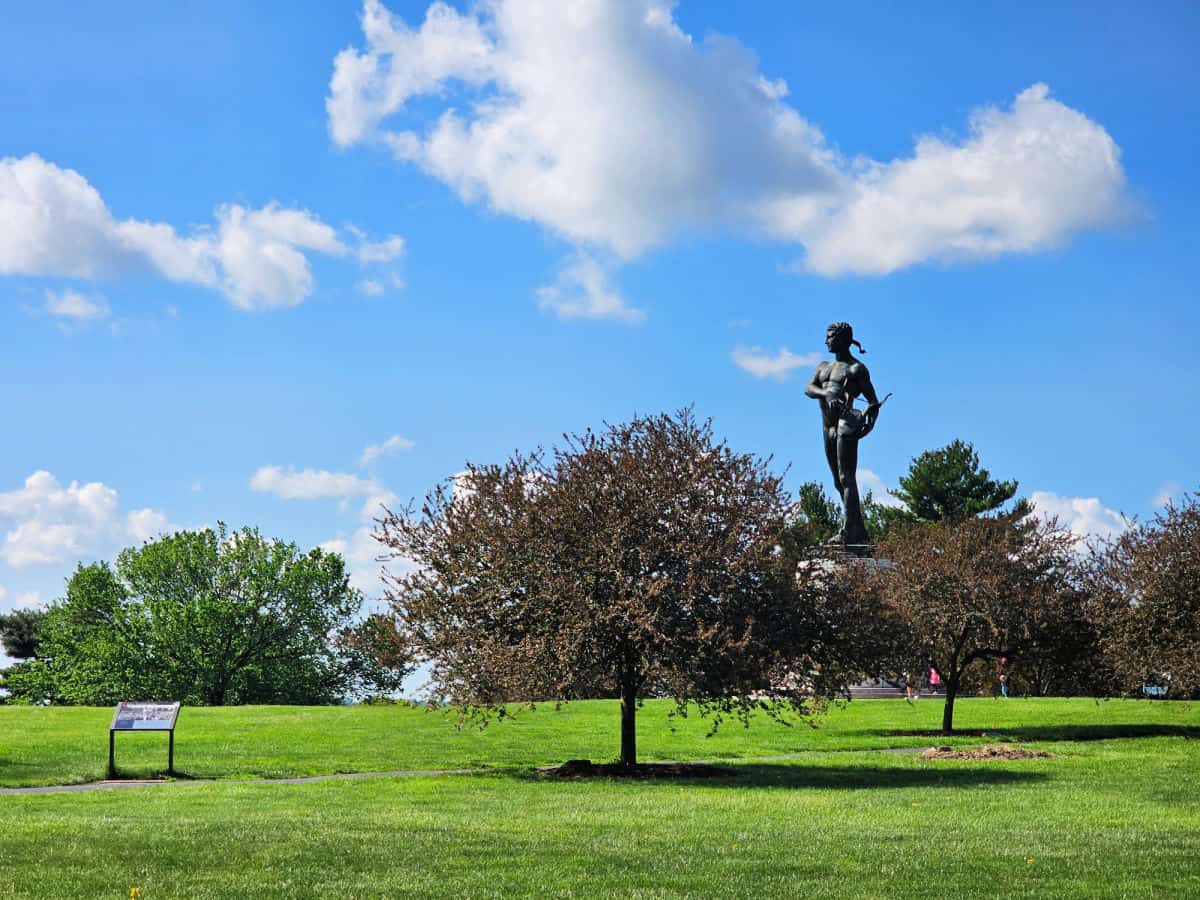
History of Fort McHenry National Monument and Historic Shrine
Fort McHenry National Monument and Historic Shrine has protected the city of Baltimore since the American Revolution.
Fort McHenry was built on the original site of the earthen star fort known as Fort Whetstone. Completed in 1803, Fort McHenry played a pivotal role during the War of 1812 Battle of Baltimore.
Fort McHenry National Monument and Historic Shrine was the last line of defense for the United States in 1814. Washington, the capital, had fallen to the British, and Baltimore became their next target.
During the Battle of Baltimore, Fort McHenry was shelled for twenty-five hours by the British Royal Navy.
The events during the Battle of Baltimore inspired the poem “The Defense of Fort McHenry" by Francis Scott Key. This poem was transformed into a song called “The Star-Spangled Banner,” and would later become the American National Anthem.
Fort McHenry During the War of 1812
In 1812 the young nation of the United States of America declared war on Britain. The War of
1812, as it became known, was caused by Britain violating the maritime rights of American sailors and trying to limit America's opportunities to trade.
By 1814, the American capital city of Washington D.C had been taken by the British. Three weeks later, the British set their sights on the port city of Baltimore, the third-largest city in America. On September 12th, 1814, the British Navy attacked Baltimore.
55 ships and roughly 4,500 British soldiers attacked the 15,000 American soldiers protecting Baltimore. 1,000 men were stationed at Fort McHenry, ready to take on the full force of the British Navy.
The British soldiers struggled to make it past the Americans in the defensive earthworks surrounding the city.
The hope was that the Royal Navy could bomb Fort McHenry into surrender, which would mean they could enter the port and reinforce the British soldiers fighting in the earthworks surrounding the city.
Fort McHenry withstood twenty-five hours of continuous heavy bombardment from the naval ships. On September 14th, 1814, the 1,000 men continued to defend Fort McHenry. The American soldiers raised the American flag to signal they had not and would not surrender to the Royal Navy.
The raising of the American flag on September 14th inspired Francis Scott Key to write the poem “The Star-Spangled Banner,” which became the American National anthem in 1933.
The American soldiers at Fort McHenry had saved Baltimore from falling to the British. Not long after the Battle of Baltimore, the British were beaten in the Battle of New Orleans, which would be the last battle of the War of 1812.
Fort McHenry During the Civil War
After the War of 1812, Fort McHenry remained an active military fortification. Many additions were made to the fort after the end of the War of 1812.
The War of 1812 would not be the last conflict in which Fort McHenry would play a role. The American Civil War broke out in 1861 between the northern and southern states.
Fort McHenry was under Union control when the tensions between the North and South erupted into Civil War. When the Union soldiers marched through Baltimore on their way to defend the Union capital in Washington D.C, violence ensued between the residents of Baltimore who supported the Confederates and the Union soldiers.
The incident, which left several civilians and Union soldiers dead or wounded, became known as the Pratt Street Riots. Although Maryland was a slave-owning border state, it did not secede like the other slave-owning states. Baltimore was home to the largest population of free African Americans in the United States.
Baltimore found itself in a peculiar situation during the Civil War, with many of its residents supporting the Confederate cause and many supporting the Union cause. Fort McHenry was not involved in any battles during the Civil War, but it did function as a prison.
During the American Civil War, Confederate sympathizers were imprisoned at Fort McHenry. From 1861 until 1865, over 2,000 civilians from Maryland were detained indefinitely at the fort as political prisoners, earning Fort McHenry the nickname the ‘American Bastille.’
Fort McHenry During World War I
After the end of the American Civil War, many of the older generations of fortifications became obsolete due to advances in weapons technology made during the war. Fort McHenry was no exception and was no longer strategically important to the defense of Baltimore.
Fort McHenry was used by the U.S Army once again in 1917 when America became involved in the Great War that had engulfed Europe in 1914. Fort McHenry and the grounds surrounding it served as a hospital called General Hospital No. 2 from 1917 until 1925.
Fort McHenry After World War I
When the last patient left the hospital at Fort McHenry, it no longer served as an active military post. Instead, the U.S Army began restoring Fort McHenry to look as it would have during the War of 1812.
The fort came under the protection of the National Parks Service in 1933. Still, as with many National Parks sites during World War II, it was used as a training facility.
Fort McHenry is the only National Park site that is a National Monument and a Historic Shrine, as the events during the Battle of Baltimore in 1814 inspired the American national anthem.
The Star Spangled Banner by Francis Scott Key
O say, can you see, by the dawn's early light,
What so proudly we hailed at the twilight's last gleaming?
Whose broad stripes and bright stars through the perilous fight,
O'er the ramparts we watched were so gallantly streaming;
And the rocket's red glare, the bombs bursting in air,
Gave proof through the night that our flag was still there;
O say, does that star-spangled banner yet wave
O'er the land of the free, and the home of the brave?
On the shore dimly seen through the mists of the deep,
Where the foe's haughty host in dread silence reposes,
What is that which the breeze, o'er the towering steep,
As it fitfully blows, now conceals, now discloses?
Now it catches the gleam of the morning's first beam,
In full glory reflected now shines on the stream;
'Tis the star-spangled banner; O long may it wave
O'er the land of the free, and the home of the brave!
And where is that band who so vauntingly swore
That the havoc of war and the battle's confusion
A home and a country should leave us no more?
Their blood has washed out their foul footsteps' pollution.
No refuge could save the hireling and slave,
From the terror of flight and the gloom of the grave;
And the star-spangled banner in triumph doth wave
O'er the land of the free, and the home of the brave!
O! thus be it ever, when freemen shall stand
Between their loved homes and the war's desolation!
Blest with victory and peace, may the heav'n-rescued land,
Praise the power that hath made and preserved us a nation.
Then conquer we must, for our cause it is just.
And this be our motto— "In God is our trust; "
And the star-spangled banner in triumph shall wave
O'er the land of the free, and the home of the brave.
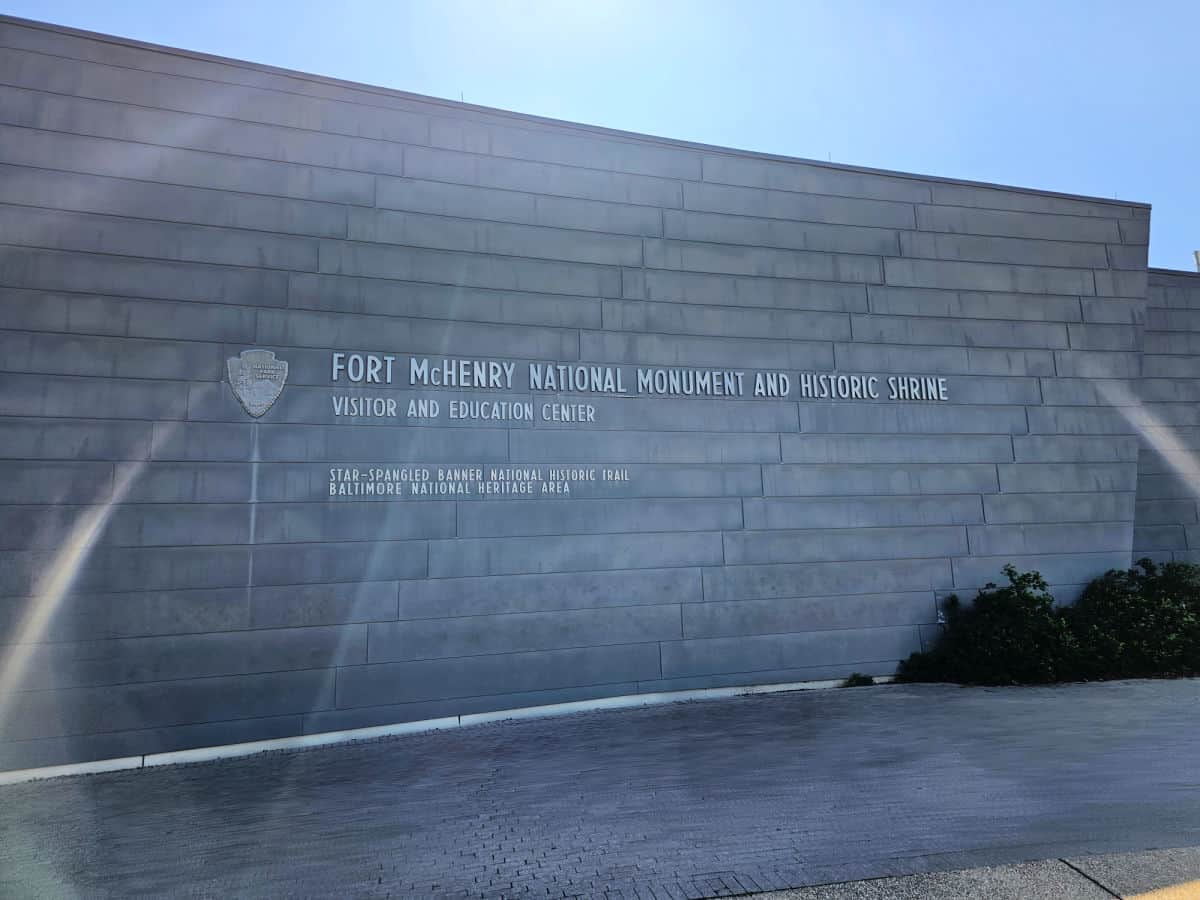
Things to know before your visit Entrance fee
$0.00 - For children 15 years of age and younger.
$15.00 - Per adult 16 years of age and older.
Learn more about National Park Passes for parks that have an entrance fee.
$80.00 - For the America the Beautiful/National Park Pass. The pass covers entrance fees to all US National Park Sites and over 2,000 Federal Recreation Fee Sites for an entire year and covers everyone in the car for per-vehicle sites and up to 4 adults for per-person sites.

Buy your pass at this link, and REI will donate 10% of pass proceeds to the National Forest Foundation, National Park Foundation, and the U.S. Endowment for Forestry & Communities.
National Park Free Entrance Days -Mark your calendars with the five free entrance days the National Park Service offers annually.
Time Zone
Eastern Time Zone
Pets
Fort McHenry National Monument and Historic Shrine is a pet-friendly park, with some restrictions. Pets are allowed in designated areas but must be on a leash not exceeding six feet.
They are not allowed in the Historic Zone, Star Fort, or any buildings including the Visitor and Education Center.
Cell Service
Cell service at Fort McHenry National Monument and Historic Shrine can vary depending on your provider and the specific location within the park. Generally, you can expect decent cell reception in most areas, as the park is located close to Baltimore City.
Park Hours
Park grounds and parking lot are open from 9:00 am to 5:00 pm, while the Star Fort, Visitor Center, gift shop, and restrooms operate from 9:00 am to 4:45 pm. Closed during New Year’s, Thanksgiving and Christmas Day.
Wi-Fi
There is no public Wi-Fi available at the park.
Insect Repellent
Insect repellent is always a great idea when outdoors, especially if you are around any body of water.
We use Permethrin Spray on our clothes before our park trips.
Water Bottle
Make sure to bring your own water bottle and plenty of water with you. Plastic water bottles are not sold in the park.
Parking
Free parking is offered on a first-come, first-served basis. Utilize the designated bus lane for group drop-off/pick-up. No vehicles may park, idle, or load/unload in the fire lane by the Visitor and Education Center. Buses must use designated spaces; if full, park offsite.
Food/Restaurants
There are no restaurants on-site but visitors are allowed to bring their own food for picnics in designated areas within the park.
Additionally, there are numerous dining options, including restaurants and cafes, in the nearby neighborhoods of Baltimore, just a short drive from the historic site.
Gas
The park does not have any gas stations on its premises, but you can locate fueling stations in nearby areas, particularly closer to Baltimore.
Drones
Drones are not permitted within National Park Sites.
National Park Passport Stamps
National Park Passport stamps can be found in the visitor center.
We like to use these circle stickers for park stamps so we don't have to bring our passport book with us on every trip.
The National Park Passport Book program is a great way to document all of the parks you have visitied.
You can get Passport Stickers and Annual Stamp Sets to help enhance your Passport Book.
The park has the following cancellation stamps:
Fort McHenry NM & HS
Star-Spangled Banner National Historic Trail
Chesapeake Bay Gateways Network
Lazaretto Point Lighthouse
Fort McHenry National Monument and Historic Shrine is part of the 1993 Passport Stamp Set and 2014 Passport Stamp Set.
Electric Vehicle Charging
Electric vehicle (EV) charging stations are conveniently located near Fort McHenry National Monument and Historic Shrine.
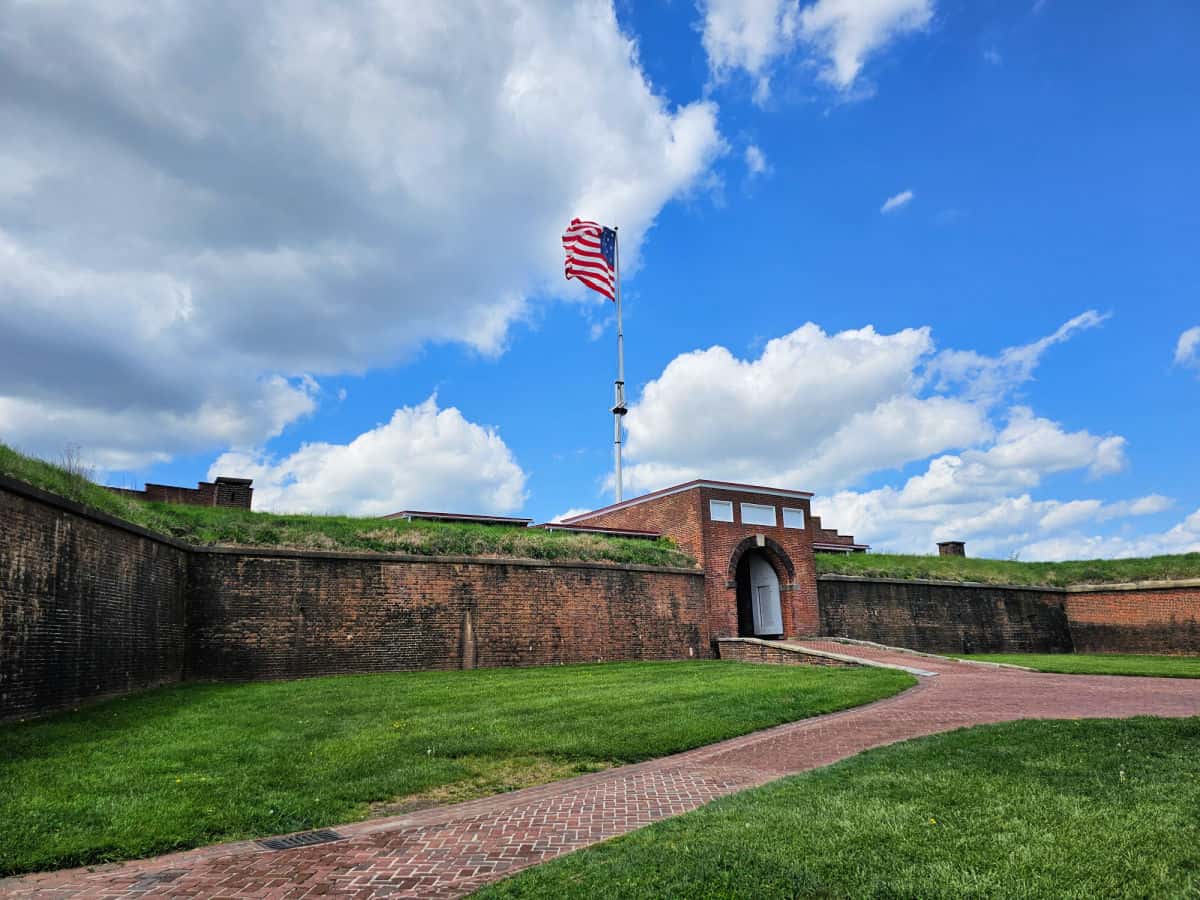
Details about Fort McHenry National Monument and Historic Shrine
Size - 47 acres
Check out how the park compares to other National Parks by Size.
Date Established
Fort McHenry National Monument and Historic Shrine was established as a national park in 1925 and redesignated in 1939.
Visitation
In 2022, Fort McHenry NM & HS had 223,957 park visitors.
In 2021, Fort McHenry NM & HS had 150,075 park visitors.
In 2020, Fort McHenry NM & HS had 163,224 park visitors.
In 2019, Fort McHenry NM & HS had 419,545 park visitors.
Learn more about the most visited and least visited National Parks in the US
National Park Address
2400 East Fort Avenue
Baltimore, MD 21230
National Park Map
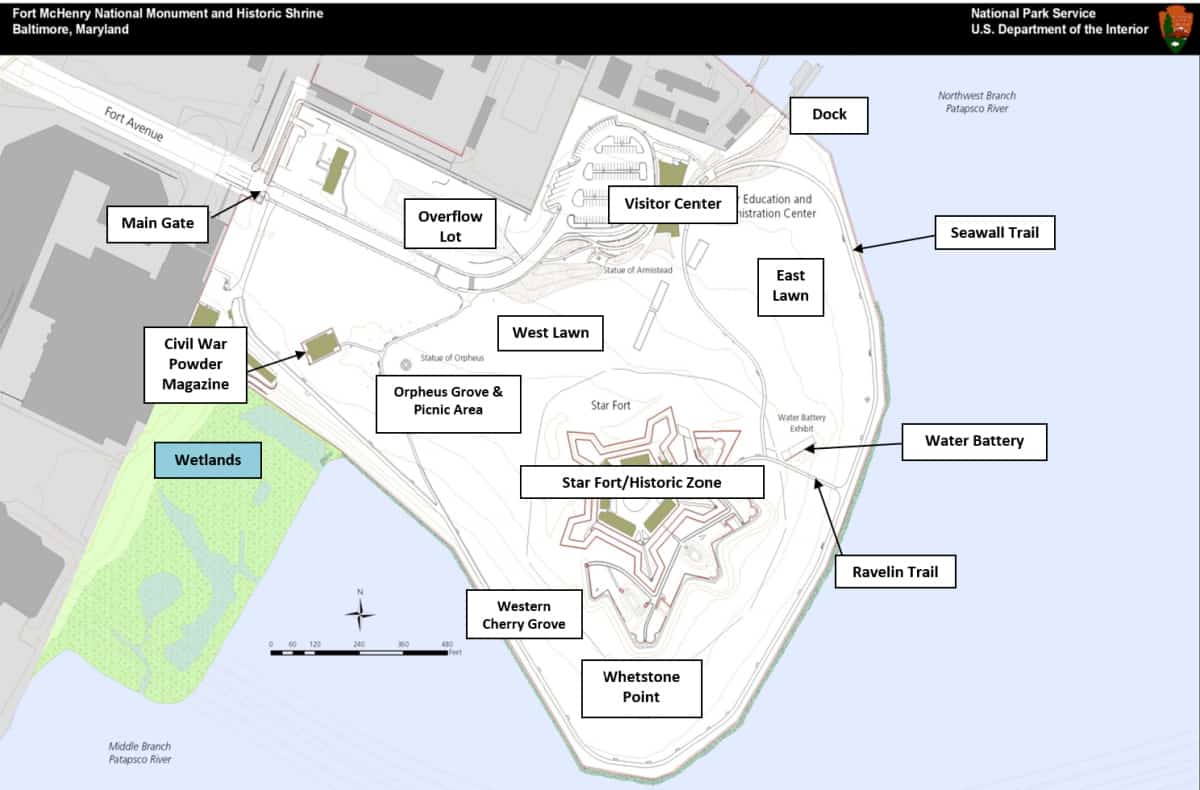
Where is Fort McHenry National Monument and Historic Shrine?
Fort McHenry National Monument and Historic Shrine is situated on a picturesque peninsula in Baltimore, Maryland, surrounded by water on three sides. The location offers stunning views of the Patapsco River and the Baltimore Harbor, with the city skyline in the distance.
Estimated distance from major cities nearby
- Washington, DC - 39 miles
- Philadelphia, PA - 104 miles
- Newark, NJ - 181 miles
- Jersey City, NJ - 186 miles
- Norfolk, VA - 235 miles
- New York, NY - 189 miles
- Virginia Beach, VA - 249 miles
- Chesapeake, VA - 246 miles
- Pittsburgh, PA - 248 miles
Estimated Distance from nearby National Park
Shenandoah National Park - 113 miles
Acadia National Park - 669 miles
New River Gorge National Park - 339 miles
Cuyahoga Valley National Park - 353 miles
Mammoth Cave National Park - 670 miles
Where is the National Park Visitor Center?
The National Park Visitor Center for Fort McHenry National Monument and Historic Shrine is located on the grounds of the historic site itself.
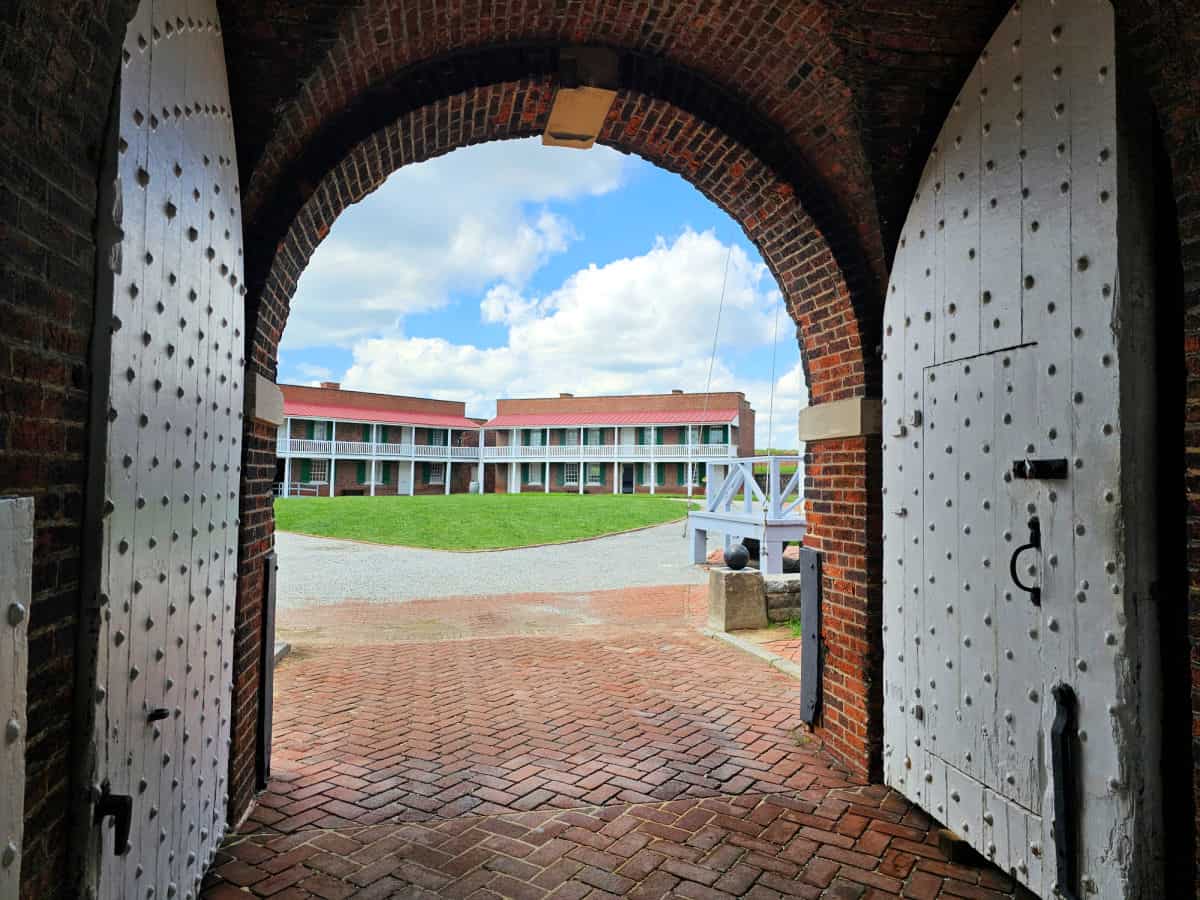
Getting to Fort McHenry National Monument and Historic Shrine
Closest Airports
Baltimore/Washington International Thurgood Marshall Airport (BWI/KBWI)
Ronald Reagan Washington National Airport (DCA/KDCA)
Washington Dulles International Airport (IAD/KIAD)
International Airports
Harrisburg International Airport (MDT/KMDT)
Philadelphia International Airport (PHL/KPHL)
Regional Airports
Hagerstown Regional Airport (HGR/KHGR)
Salisbury-Ocean City Wicomico Regional Airport (SBY/KSBY)
Driving Directions
The park is three miles southeast of the Baltimore Inner Harbor and just off I-95. Follow the brown Fort McHenry directional signs along all major routes to the park.
- From I-95 northbound, take Exit 55 to Key Highway and follow Fort McHenry signs.
- From I-95 southbound, as you approach the Fort McHenry Tunnel, move to the toll
- booths on the far right as you will be exiting immediately after emerging from the tunnel. Take Exit 55 to Key Highway and follow the Fort McHenry signs using Lawrence Street and not Woodall, as your GPS might indicate.
- From the Inner Harbor, take Light Street south to Key Highway. Turn left and follow the Fort McHenry signs to Lawrence Street. Turn right on Lawrence Street and then left on Fort Avenue to the park.
- The most direct route to Fort McHenry is I-95. Take Exit 55 and drive to the light at Key Highway. Follow the signs to the fort. At the third light on Key Highway, turn left onto Lawrence Street. Turn left at the next light and Fort Avenue will bring you to Fort McHenry.
Public Transportation
Outside the main entrance to the park, there is a bus stop where guests can catch Maryland Transit Administration (MTA) buses or the Charm City Circulator.
Be aware that MTA buses require payment of a fare, while the Charm City Circulator can be used at no cost.
Water Transportation
Fort McHenry can be reached via the Baltimore Water Taxi, which offers service from several points around the Inner Harbor.
Keep in mind that schedules are subject to change based on the season, and tickets cannot be bought at Fort McHenry.
To visit the fort using the Water Taxi, visitors must embark at other locations in the Inner Harbor area and can leave by the same means.
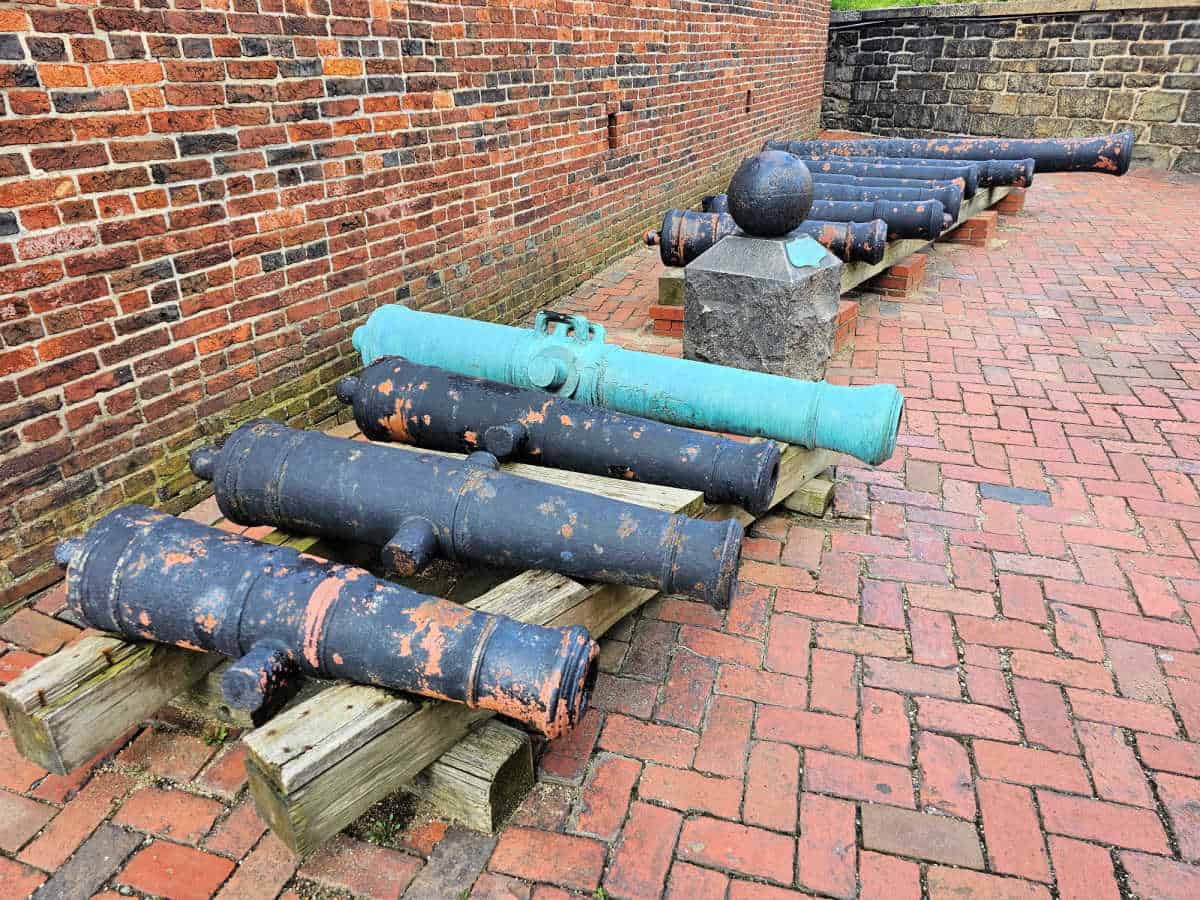
Best time to visit
The best time to visit Fort McHenry National Monument and Historic Shrine is during the spring and fall months, when the weather is mild, and the park's natural beauty is at its peak.
In spring, witness the blossoming of flowers and trees, while the fall season brings stunning foliage and cooler temperatures.
These seasons offer comfortable conditions for exploring the historic site, taking part in the available programs, and enjoying the picturesque views of Baltimore Harbor.
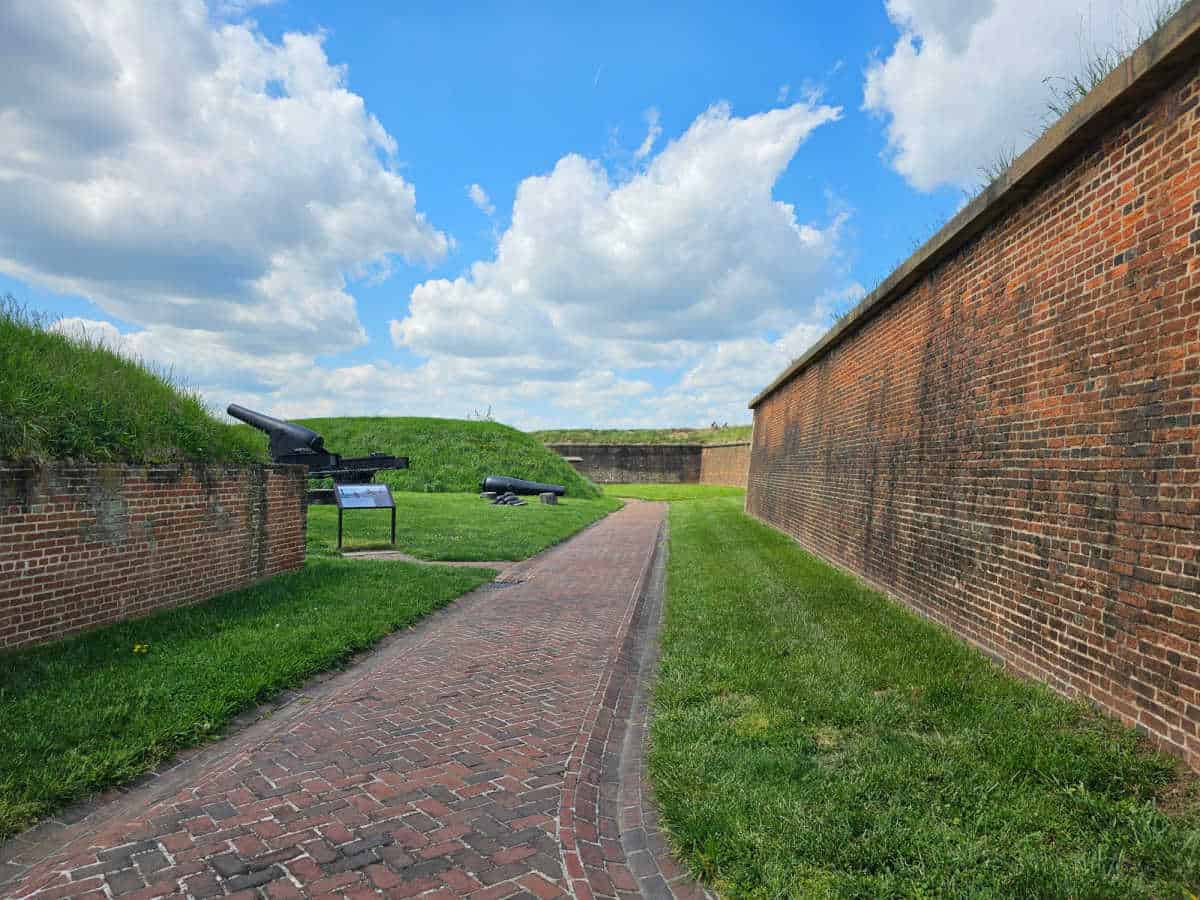
Weather and Seasons
The hottest season is from May 30th to September 15th, with an average daily high temperature above 79 degrees.
The coldest season is from December 1st to March 8th, with an average daily high temperature below 52 degrees.
The snowiest season is from November 27th to March 21st, with snowfall of at least 1 inch a month. It snows the most in February, with an average of 5.6 inches.
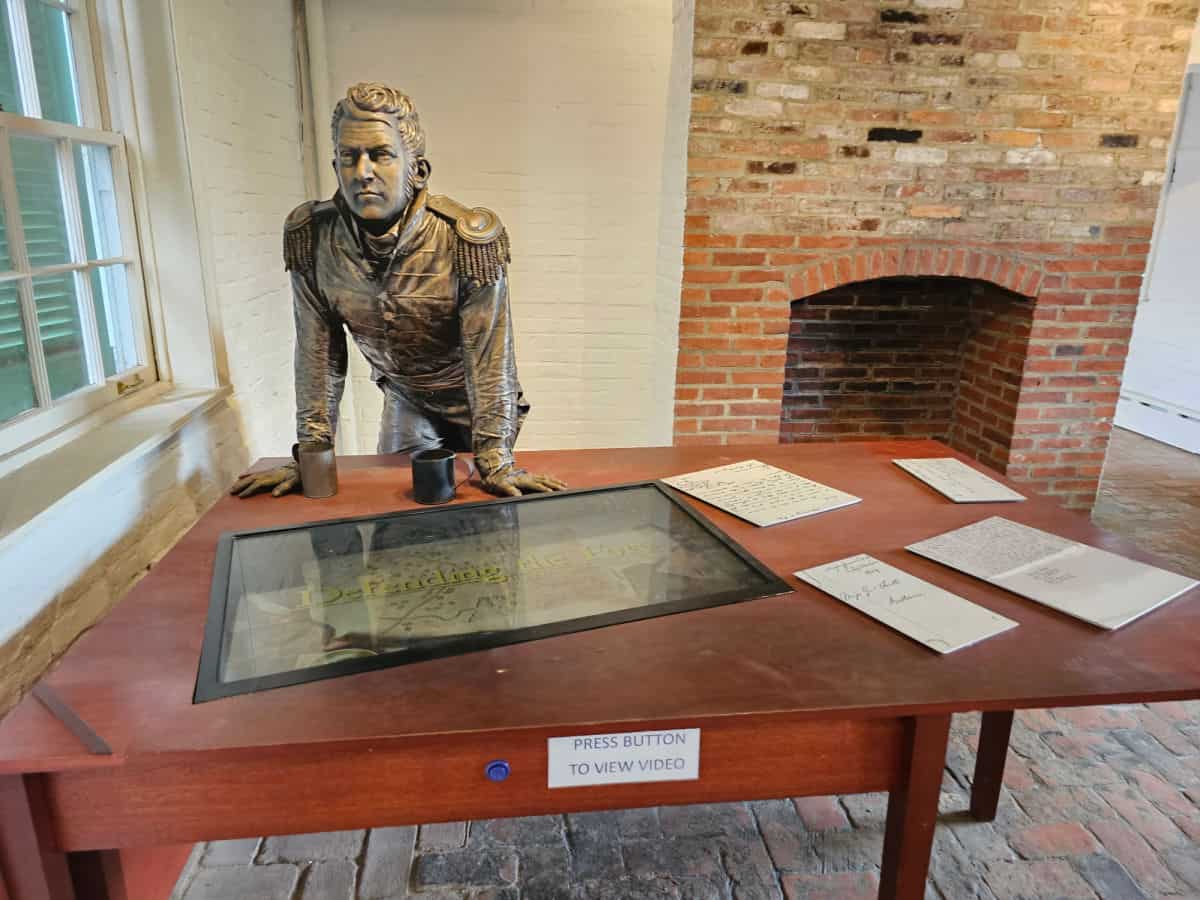
Best Things to do in Fort McHenry
We suggest planning at minimum a few hours to explore the park.
Visitor Center and Museum
Unravel the fascinating history of Fort McHenry at the Visitor Center and Museum. Exhibits showcase the fort's role in the War of 1812, the creation of the Star-Spangled Banner, and the lasting impact on American culture. Don't miss the educational film, "The Battle for Baltimore," to understand the site's significance.
Junior Ranger Program
Get your kids involved in the fun and educational Junior Ranger Program! Children aged 5-13 can complete activity booklets, engage in hands-on learning experiences, and earn a badge as they explore the fort. It's a fantastic way for the whole family to learn about history while creating lasting memories.
Historic Star-Shaped Fort
Step back in time as you wander through Star Fort, the heart of Fort McHenry. Walk along the historic ramparts, admire the breathtaking views of the Baltimore harbor, and delve into the stories of the soldiers who once defended these grounds. The Star Fort is a must-visit for history buffs and casual travelers alike.
Ranger Programs
The Park Ranger programs at Fort McHenry are amazing! They offer the Morning Flag change, Battle of Baltimore, Flag Talks, War in the Chesapeake, American Bastille: Civil War at Fort McHenry, and the Evening Flag Change.
The daily flag change is great for visitors of all ages. We heard a young girl jumping up and down with joy in excitement that she was able to help with the flag change.
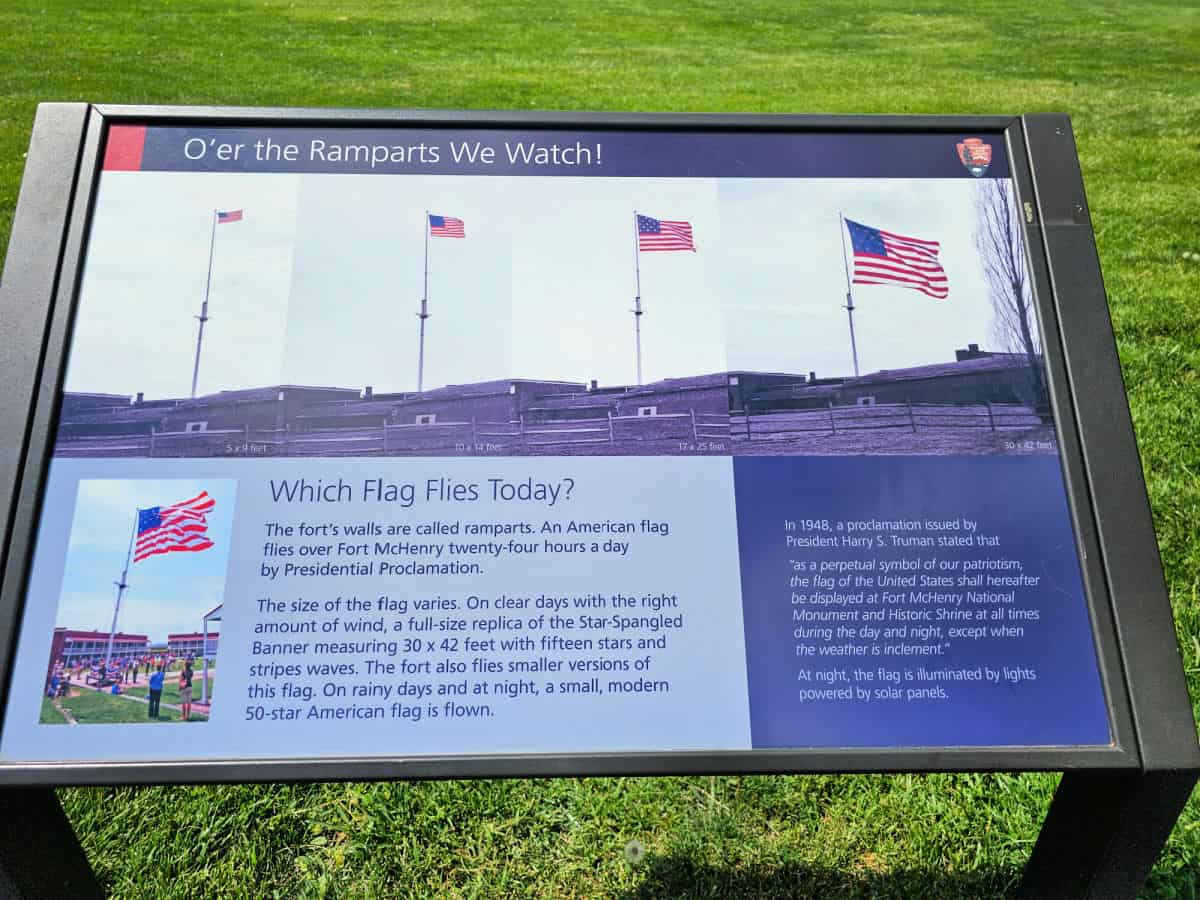
Hiking
While there are no specific hiking trails in the park there is a walking path around the park that is gorgeous!
Always carry the 10 essentials for outdoor survival when exploring.
How to beat the crowds
We suggest arriving early so you can attend the flag raising ceremony and enjoy the park before it gets busy.
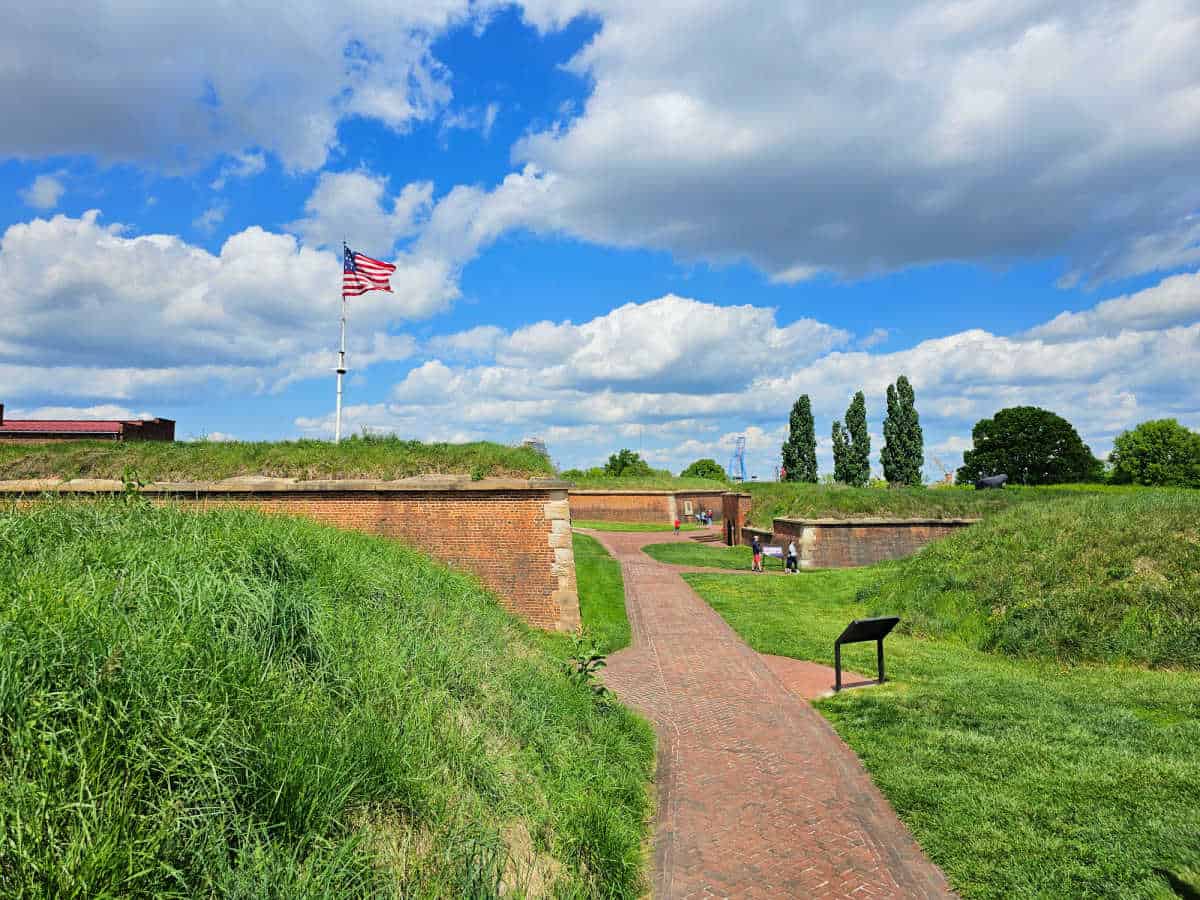
Where to stay when visiting Fort McHenry
There are no National Park Lodges within the park.
Nearby lodging includes:
Courtyard by Marriott Baltimore Downtown/McHenry Row - 3-star hotel. Near Baltimore Cruise Terminal, Courtyard by Marriott Baltimore Downtown/McHenry Row provides a free grocery shopping service, a firepit, and a coffee shop/café. Be sure to enjoy a meal at The Bistro, the onsite bistro. Stay connected with free Wi-Fi in public areas, with speed of 100+ Mbps (good for 1–2 people or up to 6 devices), and guests can find other amenities such as dry cleaning/laundry services and an outdoor entertainment area.
The Inn at Henderson's Wharf, Ascend Hotel Collection - 3-star hotel. Located close to National Aquarium in Baltimore and Baltimore Cruise Terminal, The Inn at Henderson's Wharf, Ascend Hotel Collection provides a marina, a free manager's reception, and a terrace. Stay connected with free in-room Wi-Fi, and guests can find other amenities such as a garden and dry cleaning/laundry services.
Sagamore Pendry Baltimore - 5-star luxury hotel. Located close to National Aquarium in Baltimore, and provides a roundtrip airport shuttle, a poolside bar, and a terrace. Treat yourself to a sports massage or other spa services. In addition to a garden and dry cleaning/laundry services, guests can connect to free in-room Wi-Fi.
Canopy by Hilton Baltimore Harbor Point - 4-star hotel. National Aquarium in Baltimore and Baltimore Cruise Terminal are located near Canopy by Hilton Baltimore Harbor Point, which provides a terrace, dry cleaning/laundry services, and a fireplace in the lobby. The onsite southern cuisine seafood restaurant, Cindy Lou's Fish House, features ocean views and brunch. In addition to a bar and a gym, guests can connect to free in-room Wi-Fi.
Click on the map below for additional vacation rentals and hotels near the park.
Camping
There are no National Park Campgrounds within the park.

For a fun adventure check out Escape Campervans. These campervans have built in beds, kitchen area with refrigerators, and more. You can have them fully set up with kitchen supplies, bedding, and other fun extras. They are painted with epic designs you can't miss!
Escape Campervans has offices in Vancouver, Seattle, Portland, San Francisco, Las Vegas, Los Angeles, Phoenix, Salt Lake City, Denver, New York, and Orlando

Parks Near Fort McHenry National Monument
Hampton National Historic Site
First State National Historical Park
Harriet Tubman Underground Railroad National Historical Park
Rock Creek Park
Check out all of the National Parks in Maryland along with neighboring National Parks in Delaware, National Parks in Pennsylvania, National Parks in Virginia, and West Virginia National Parks





Leave a Reply